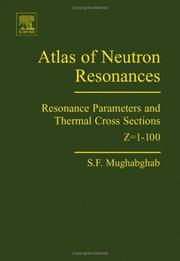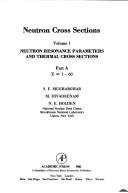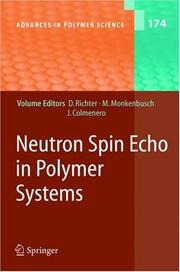| Listing 1 - 6 of 6 |
Sort by
|

ISBN: 9780444520357 044452035X Year: 2006 Publisher: Boston (Mass.) : Elsevier,
Abstract | Keywords | Export | Availability | Bookmark
 Loading...
Loading...Choose an application
- Reference Manager
- EndNote
- RefWorks (Direct export to RefWorks)
The "Atlas of Neutron Resonances" provides detailed information on neutron resonances, thermal neutron cross sections, and average resonance properties which are important to neutron physicist, astrophysicists, solid state physicists, reactor engineers, scientists involved in activation analysis, and evaluators of neutron cross sections. The long introduction can serve as a text book for students and researcher involved in neutron research. This book represents the fifth edition of what was previously well known as the Brookhaven National Laboratory BNL-325 reports, which are frequently referenced worldwide. Compilation and evaluation of the world's thermal neutron cross-sections and resonance parameters for neutron physicists, reactor engineers, and neutron evaluators. Compilation and evaluation of coherent scattering lengths for solid state physicists and evaluators Compilation and evaluation of average 30-keV capture cross sections for astrophysicists. Nuclear level density parameters derived from average spacings of neutron resonances following a new approach (new feature for this edition). Brief review of sub-threshold fission. Comparisons of optical model predictions with neutron strength function data and scattering lengths. Estimation of average E1 radiative widths on the basis of the generalized Landau-Fermi liquid model (a new feature for this edition).


ISBN: 0125097018 Year: 1981 Publisher: New York (N.Y.) : Academic press,
Abstract | Keywords | Export | Availability | Bookmark
 Loading...
Loading...Choose an application
- Reference Manager
- EndNote
- RefWorks (Direct export to RefWorks)
Neutron cross sections --- Neutron resonance --- Thermal neutrons --- Tables.
Book
ISBN: 044463780X 0444637869 9780444637802 9780444637864 Year: 2018 Publisher: Amsterdam, Netherlands : Elsevier,
Abstract | Keywords | Export | Availability | Bookmark
 Loading...
Loading...Choose an application
- Reference Manager
- EndNote
- RefWorks (Direct export to RefWorks)
Neutron resonance --- Thermal neutrons --- Thermalization of neutrons --- Neutrons --- Nuclear reactors --- Nuclear magnetic resonance --- Resonance
Book
ISBN: 0444637796 0444637699 9780444637796 9780444637697 Year: 2018 Publisher: Amsterdam, Netherlands : Elsevier,
Abstract | Keywords | Export | Availability | Bookmark
 Loading...
Loading...Choose an application
- Reference Manager
- EndNote
- RefWorks (Direct export to RefWorks)
Neutron resonance --- Thermal neutrons --- Thermalization of neutrons --- Neutrons --- Nuclear reactors --- Nuclear magnetic resonance --- Resonance
Book
ISBN: 3540627138 3540684492 Year: 1997 Volume: 134 Publisher: Berlin Springer
Abstract | Keywords | Export | Availability | Bookmark
 Loading...
Loading...Choose an application
- Reference Manager
- EndNote
- RefWorks (Direct export to RefWorks)
Viscoelasticandtransportpropertiesofpolymersintheliquid(solution,melt)or liquid-like (rubber) state determine their processing and application to a large extent and are of basic physical interest [1—3]. An understanding of these dynamic properties at a molecular level, therefore, is of great importance. However,thisunderstandingiscomplicatedbythefactsthatdi?erentmotional processes may occur on di?erent length scales and that the dynamics are governed by universal chain properties as well as by the special chemical structure of the monomer units [4,5]. The earliest and simplest approach in this direction starts from Langevin equations with solutions comprising a spectrum of relaxation modes [1—4]. Special features are the incorporation of entropic forces (Rouse model, [6]) which relax uctuations of reduced entropy, and of hydrodynamic interactions (Zimm model, [7]) which couple segmental motions via long-range back ow elds in polymer solutions, and the inclusion of topological constraints or entanglements (reptation or tube model, [8—10]) which are mutually imposed within a dense ensemble of chains. Another approach, neglecting the details of the chemical structure and concentratingontheuniversalelementsofchainrelaxation,isbasedondynamic scalingconsiderations[4,11].Inparticularinpolymersolutions,thisapproach o?ers an elegant tool to specify the general trends of polymer dynamics, although it su?ers from the lack of a molecular interpretation. A real test of these theoretical approaches requires microscopic methods, which simultaneously give direct access to the space and time evolution of the segmental di?usion. Here, quasi-elastic scattering methods play a crucial role sincetheyallowthemeasurementofthecorrespondingcorrelationfunctions.In particular,thehigh-resolutionneutronspinecho(NSE)spectroscopy[12—15]is very suitable for such investigations since this method covers an appropriate range in time (0.005)t/ns)40) and space (r/nm [15). Furthermore, the possibilityoflabellingbyhydrogen-deuteriumexchangeallowstheobservation of single-chain behavior even in the melt.
fysicochemie --- Macromolecules --- reologie --- Polymers --- Neutron spin echoes. --- Rheology. --- Viscoelasticity. --- Polymères --- Echos de spins de neutrons --- Rhéologie --- Viscoélasticité --- Analysis. --- Analyse --- Neutron spin echoes --- Rheology --- Viscoelasticity --- Organic Chemistry --- Chemistry --- Physical Sciences & Mathematics --- Analysis --- Polymères --- Rhéologie --- Viscoélasticité --- Continuum mechanics --- Elasticity --- Viscosity --- Relaxation phenomena --- Colloids --- Deformations (Mechanics) --- Plasticity --- Echoes, Neutron spin --- Spin echoes, Neutron --- Neutron resonance --- Polymers . --- Condensed matter. --- Polymer Sciences. --- Condensed Matter Physics. --- Condensed materials --- Condensed media --- Condensed phase --- Materials, Condensed --- Media, Condensed --- Phase, Condensed --- Liquids --- Matter --- Solids --- Polymere --- Polymeride --- Polymers and polymerization

ISBN: 3540228624 3540315640 Year: 2005 Volume: 174 Publisher: Berlin, Germany ; New York, United States : Springer,
Abstract | Keywords | Export | Availability | Bookmark
 Loading...
Loading...Choose an application
- Reference Manager
- EndNote
- RefWorks (Direct export to RefWorks)
Neutron spin echoes --- Polymers --- Echos de spins de neutrons --- Polymères --- Analysis --- Analyse --- Nuclear Physics --- Organic Chemistry --- Physics --- Chemistry --- Physical Sciences & Mathematics --- Neutron spin echoes. --- Analysis. --- Polymères --- EPUB-LIV-FT SPRINGER-B --- Polymere --- Polymeride --- Polymers and polymerization --- Echoes, Neutron spin --- Spin echoes, Neutron --- Chemistry. --- Physical chemistry. --- Polymers. --- Condensed matter. --- Polymer Sciences. --- Condensed Matter Physics. --- Physical Chemistry. --- Chemistry, Theoretical --- Physical chemistry --- Theoretical chemistry --- Physical sciences --- Condensed materials --- Condensed media --- Condensed phase --- Materials, Condensed --- Media, Condensed --- Phase, Condensed --- Liquids --- Matter --- Solids --- Macromolecules --- Chemistry, Physical organic. --- Chemistry, Physical organic --- Chemistry, Organic --- Chemistry, Physical and theoretical --- Polymers . --- Neutron resonance
| Listing 1 - 6 of 6 |
Sort by
|

 Search
Search Feedback
Feedback About UniCat
About UniCat  Help
Help News
News